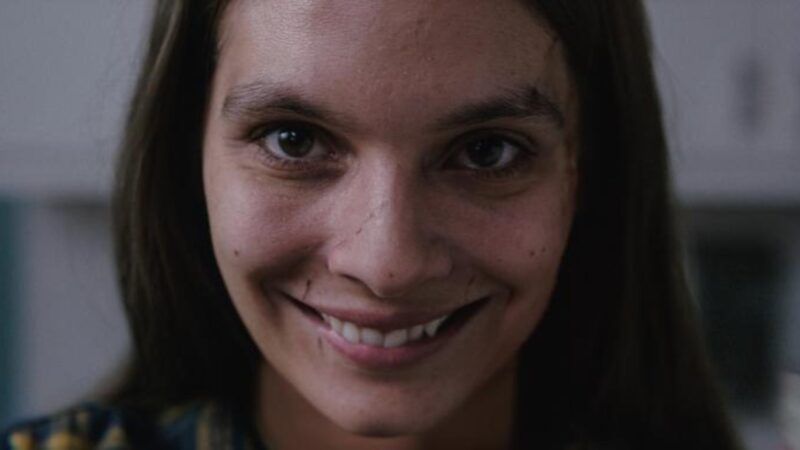Review: Smile
Stressed to kill.

Let's call it the demon leer—the horror-movie effect created by pasting an incongruous grin across the face of a character who, on the evidence of a cold, soul-piercing stare and corpselike quietude, is clearly deranged. The appeal of this effect for filmmakers is that it is entirely sufficient unto itself. Like the jump scare—the similarly cheap thrill with which it is sometimes allied—it can be dropped into any movie, at any point, and be counted on to work its sinister magic without a lot of narrative botheration.
As a cinematic resource, the demon leer can be traced back at least to The Man Who Laughs, a 1928 silent film for which Universal's soon-to-be makeup master Jack Pierce devised a bizarre, toothy prosthetic look for the story's maimed protagonist. The Man Who Laughs isn't a horror movie: It's a romantic fantasy along the lines of The Hunchback of Notre Dame, Universal's Lon Chaney hit of five years earlier. But Pierce's makeup design for the film has been influential in the horror genre—most clearly on the Marvel characters Venom and Carnage—and was a model for the Joker, the DC supervillain who debuted in the 1940 Batman #1.
Demon leers have been with us ever since The Man Who Laughs, famously deployed by Jack Nicholson in The Shining and, most recently, by the ill-fated youths of the 2018 Blumhouse fright flick Truth or Dare, in which an evil entity lashes out from the inadequate confines of a dumb party game.
Now comes Smile, which scored a pre-release publicity coup last Friday when Paramount planted a woman projecting a demon leer (and wearing a Smile t-shirt) in the audience at a televised baseball game at the Oakland Coliseum—media catnip at its most brazen.
The movie itself, a first feature by writer-director Parker Finn, features some fine, creepy leering, much of it directed at a hospital psych-ward doctor named Rose Cotter (Sosie Bacon), who first encounters this picture's evil entity inhabiting a patient named Laura Weaver (Caitlin Stasey). Laura was traumatized by witnessing the suicide of a man who bludgeoned himself to death with a hammer (something I have trouble picturing after the first blow) right before her eyes; now she's seeing people with demon leers everywhere, "something no one else can see, except for me." Then Laura flips out and offs herself in a very bloody way right before Rose's eyes.
After rather more nosing around than one might wish to sit through (the movie is overlong at nearly two hours), we learn that there is in fact an evil spirit on the loose, that it thrives on the trauma engendered by suicide, and that Rose still suffers from the childhood shock of losing her own mother in this way. She becomes obsessed with that memory, which alienates her fiancé (Jessie T. Usher) and her hospital boss (Kal Penn). But then she reunites with a ex-boyfriend Joel (Kyle Gallner), a cop who proves to be quite helpful. She also reunites with…oops: never mind.
I wish director Finn had maintained tighter control of the movie's tone: It begins in a mood of grim contemplation but proceeds through a standard slurry of ripped flesh and puddled blood. And there are several elements—upside-down camera moves and pointless cat closeups—that serve no purpose (not to mention the tacking on at the end of the old Chordettes pop hit "Lollipop," for no bleedin' reason whatsoever).
There was none of this sort of thing at Universal back in the old days, of course. In the 1930s and '40s, when Jack Pierce was running the studio's monster factory and helping create such horror sensations as Frankenstein, Dracula, and the Wolf Man, the lingering spell of German Expressionism was sufficient to establish an atmosphere of dark menace without the use of gory mutilation. Anyone unfamiliar with the classic Universal horror films will have a chance to see them on a big screen this Saturday (10/1), when Regal theaters around the country will be showing two of them in what amounts to a Jack Pierce double feature.
The first of these pictures, The Mummy (1931), has already been remade twice by Universal—once successfully, with Brendan Fraser (1999), and once catastrophically, with Tom Cruise (2017). The original is slow by any current standard, but it casts a ceremonial spell. The other half of the double bill, The Bride of Frankenstein, is the best of the many movies derived from Mary Shelley's 1818 novel, not least because it features Elsa Lanchester as the shock-haired Bride, Ernest Thesiger as the dotty Doctor Pretorious, and of course Boris Karloff in his second appearance as the misunderstood monster. Universal is in the process of remaking this film right now, with Javier Bardem donning the creature's iconic neck bolts and great big boots. Long may he clomp.


Show Comments (11)